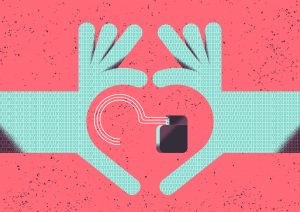The World Health Organization reports that cardiovascular disease is the leading cause of death worldwide [1]. One of these diseases is heart failure – a condition in which the heart is unable to pump enough blood to the organs in our body. This results in a deficiency of oxygen and nutrients in the cells of the body, which can have a huge impact on how it functions. Unfortunately, the number of patients with heart failure continues to grow. Moreover, the improvement of care for patients with myocardial infarction has resulted in higher survival rates, but as a result, more patients suffer from heart failure.
Of course, there is drug treatment for heart failure, but it is not always sufficient. Cardiac resynchronization therapy (CRT) exists as an option for patients with heart failure with reduced ejection fraction (HFrEF), for whom pharmacotherapy alone is insufficient to reduce symptoms and control cardiac function [2]. The aim of CRT is to restore physiologically normal electrical heart activity, which is often altered in the course of the underlying disease. This can be achieved by introducing electrodes into the vascular system which are connected to a pacemaker with a resynchronization function. Clinical trials evaluating this method showed positive results in terms of relieving symptoms and, most importantly, improving the survival rate of sufferers. Both the Comparison of Medical Therapy, Pacing and Defibrillation in Heart Failure (COMPANION) and the Cardiac Resynchronisation—Heart Failure (CARE-HF) trials [3,4], which were the cornerstone of electrotherapy in HF patients, showed up to a 36% reduction in mortality, an effect size rarely seen in trials today [5].
Cardiac resynchronization therapy – problems
Clinicians evaluate the effectiveness of CRT based on echocardiographic results, clinical evaluation and/or ECG recording. Unfortunately, not all patients benefit from CRT in the same way. According to the available data, up to one-third of patients may be classified as ‘non-responders’ [6]. The reasons for the lack of improvement in a patient’s health after receiving a CRT device should be investigated on different grounds related to HF management. Optimizing the settings of this device is a very time-consuming activity, but it can bring positive results and improve the patient’s condition. Of course, longer observation (i.e., 24-hour Holter ECG monitoring) is beneficial and may provide more information on the mechanism of CRT non-response. Unfortunately, more data means that doctors need to use more of their valuable time to assess them.
Due to the fact that doctors have a small amount of time for each patient, clinicians are looking for new solutions to support the analysis of long-term ECG records. A call for the referral and optimization of care in patients with CRT has recently been made by three European cardiac societies [7].
Is there a way to optimize the work of a clinician?
We believe so. Therefore, in cooperation with the Medical University of Warsaw, we applied for a grant from The National Center for Research and Development. The aim of this project (NCT04061434) was to develop an AI algorithm based on ECG tracings and to evaluate its ability to detect ineffective CRT pacing. Applying this method in clinical practice could potentially result in increased efficiency and better care for patients.
Results and conclusions
541 patients participated in the study, from whom 1241 recordings were collected. An evaluation of the effectiveness of CRT was performed in patients who were qualified as having had: effective CRT, ineffective CRT, and baseline rhythm without any stimulation. On the basis of the algorithm training, we achieved a good level of sensitivity in the detection of effective CRT stimulation (99.2%, with a precision of 92.4%). The error of automatic analysis for the data set prepared in this way was determined at the level of single heartbeats, which was 0.25% [8].
Our algorithm showed very positive results and its clinical application has many valuable aspects. Clinicians’ valuable time can be better managed and CRT effectiveness more quickly analyzed. As a result, CRT settings can be optimized, possibly allowing more patients to benefit from improved prognoses. Clinicians are able to provide more patients with professional care instead of analyzing long ECG tracings.
Find out more in the peer-reviewed article “Use of Machine Learning Algorithms in the Evaluation of the Effectiveness of Resynchronization Therapy”, published in the Journal of Cardiovascular Development and Disease. Cardiovascular Development and Disease
Do you conduct research in which you use ECG recordings?
Try our solution.
Get in touch with our clinical team.
Bibliography
[1] Khan, M.A.; et al. Global Epidemiology of Ischemic Heart Disease: Results from the Global Burden of Disease Study. Cureus 2020, 12, 9349.
[2] McDonagh,T.A.; et al. Corrigendum to: 2021 ESC Guidelines for the diagnosis and treatment of acute and chronic heart failure. Eur. Heart J. 2021, 42, 3599–3726.
[3] Liang, Y.; et al. Prediction of response after cardiac resynchronization therapy with machine learning. Int. J. Cardiol. 2021, 344, 120–126.
[4] Cleland, J.G.; et al. Long-term mortality with cardiac resynchronization therapy in the Cardiac Resynchronization-Heart Failure (CARE-HF) trial. Eur. J. Heart Fail. 2012, 14, 628–634.
[5] Bilchick, K.C.; et al. Bundle-Branch Block Morphology and Other Predictors of Outcome After Cardiac Resynchronization Therapy in Medicare Patients. Circulation 2010, 122, 2022–2030.
[6] Howell, S.J.; et al. Using Machine-Learning for Prediction of the Response to Cardiac Resynchronization Therapy: The SMART-AV Study. JACC Clin. Electrophysiol. 2021, 7, 1505–15.
[7] Mullens, W.; et al. Optimized implementation of cardiac resynchronization therapy. Eur. J. Heart Fail. 2020, 22, 2349–2369.
[8] Krzowski, B.; et al. The Use of Machine Learning Algorithms in the Evaluation of the Effectiveness of Resynchronization Therapy. J. Cardiovasc. Dev. Dis. 2022, 9, 17.

